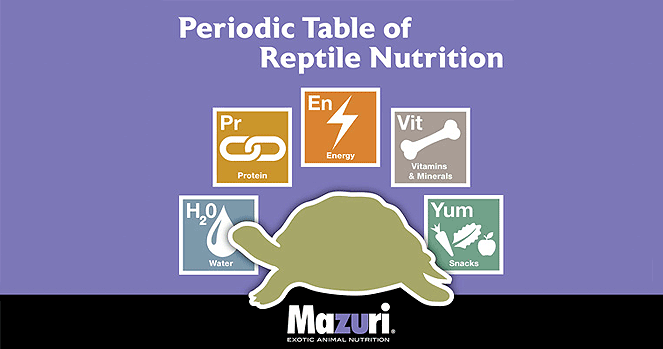The Periodic Table of Reptile Nutrition
5 elements for a complete and balanced reptile diet
Do you know how much calcium or protein is in a bug or rodent? Before you pop a pinkie mouse in the tank or corral the crickets, consider the essential elements of a reptile nutrition plan.
“Reptile diets should be both complete and balanced,” explains Eliza Trickett, regional sales manager with Mazuri®. “Complete refers to all nutrients required for the species’ age and lifestyle, while balanced means all nutrients are available in the correct amount.”
Whether feeding a tortoise, turtle, iguana or lizard, keep these five elements of reptile nutrition top-of-mind:
1. Water
Water is essential for all animals, including reptiles. Reptiles need water to drink as well as some to splash in, especially on warm days while exploring the backyard.
“Always provide plenty of clean water to your animals,” says Trickett. “Water allows cells to function and processes, such as skin shedding, are made easier with hydration.”
Depending on your reptile, determine the best way to provide water in their habitat. Reptile species native to the rainforest may prefer water in the form of a drip system or mister, while turtle and tortoise keepers may prefer to soak their reptiles regularly.
2. Protein
Proteins are composed of chains of amino acids, and each specie requires different combinations. These are essential building blocks for all living organisms, especially when the body forms muscle, enzymes and antibodies. Providing the proper amount of protein through a pelleted diet to growing reptiles can prevent conditions such as pyramiding.
“"We see pyramiding in tortoises when the individual scutes and bones of the shell form hump-like shapes,” Trickett says. “This condition can be prevented when providing a complete and balanced diet from day one, as well as an environment with higher humidity levels when hatchling tortoises are growing.”
3. Energy
Even a slow-moving turtle needs energy. These energy requirements vary depending on an animal’s life stage.
“Younger, growing and reproducing animals will require more energy than an adult,” says Trickett. “The more active your animal is, the more energy it will require.”
“Just like people, excess energy or carbohydrates in the diet can result in obesity. Energy in the form of starch can be a concern for reptile owners,” continues Trickett. “Historically, starch is used to keep food pellets held together but doesn’t provide much nutritional value. As a solution to this concern, we created a subset of diets to deliver vitamins and minerals with low starch and high fiber, as with Mazuri® Tortoise LS.”
4. Vitamins and minerals
For many reptile owners, maintaining vitamin and mineral balance is key for preventing metabolic bone disease. All reptiles, whether bearded dragons, tortoises, turtles or iguanas, are at risk of developing this disease.
“Common symptoms include soft, brittle, or deformed bones, soft and short jaws, lethargy and swollen limbs,” says Trickett. You can prevent this disease if the dietary calcium to phosphorus ratio stays between 1:1 to 2:1.”
The underlying essential element needed for calcium and phosphorus to do their job is vitamin D3. This vitamin serves as the sponge to help reptiles use calcium where they need it most.
“Vitamin D3 aids in the absorption and deposition of calcium throughout the body,” continues Trickett. “Keep in mind the UVB radiation from sunlight required for vitamin D3 synthesis does not travel well through the glass of reptile tanks. Instead of relying on the sunshine, focus on vitamin and mineral balance with pelleted diets. For insectivores such as iguanas or lizards, consider supplementing insects with high calcium gut-loading diets before feeding.”
5. Treats and snacks
Reptile owners are encouraged to offer their pets greens, veggies and some fruit. Not only is it entertaining to watch a tortoise chomp on carrots or an iguana mash a banana, but it also provides variety in your reptile’s diet.
“When feeding reptiles such as tortoises and turtles, the total diet should consist of no more than five percent fruit and 20 percent vegetables,” says Trickett. “Although reptiles eat plants and fruit in the wild, produce from the grocery store is typically higher in sugar and lower in fiber.”
“Pelleted diets should make up most of the diet and are formulated to feed with snacks,” continues Trickett. “Mazuri® makes feeding a complete and balanced diet easy because we do all of the homework, so pet owners can have peace of mind and spend more time enjoying the company of their animals.”
Mazuri® Reptile Diets are nutritionally balanced and formulated to meet the nutritional requirements of your animals.
